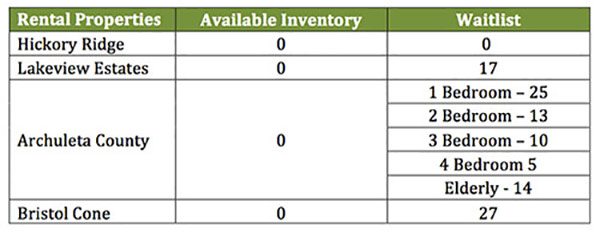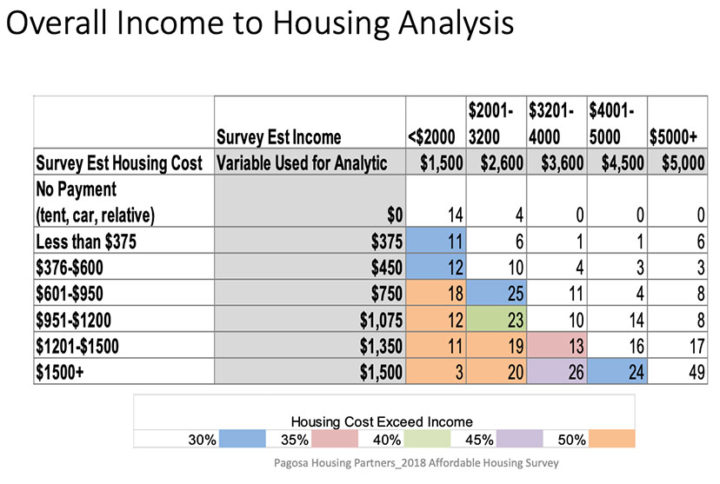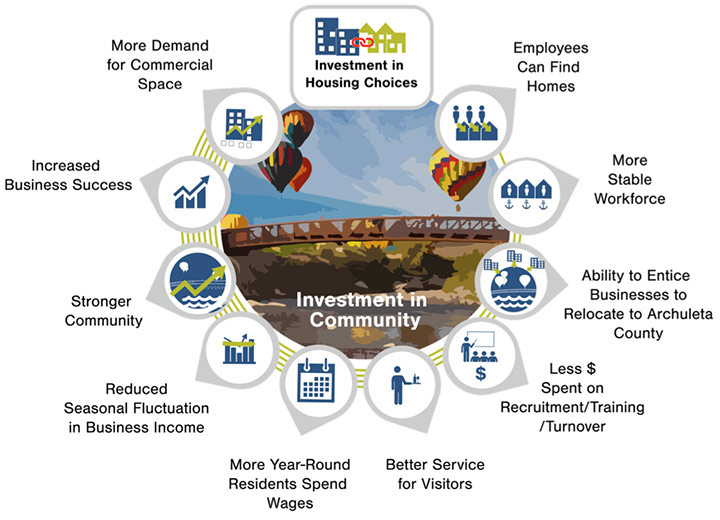On January 8, two local community activists — Lynne Vickerstaff and Joanne Whitney — appeared before the Pagosa Springs Town Council and shared an overview of a new report: “Roadmap to Affordable Housing, 2019-2025.”
Also participating in the presentation, via video feed, was Crested Butte-based housing consultant Willa Williford.
We’re listening here to Lynne Vickerstaff:
“First of all, I want to thank you for letting us work on this community problem. We’re representing Pagosa Housing Partners — PHP — we’re a non-profit focused on providing housing opportunities and choices in the community.”
PHP contracted with the Town of Pagosa Springs last July to research the Archuleta County housing crisis, and develop a comprehensive action plan for addressing the problem. Back in 2017, the Town and County governments co-funded a “housing needs study” which you can download here, and which gave us some high-level data about the housing crisis. Since July, PHP has been conducting additional surveys and research, to come up with an effective plan for tackling this crucial community issue.
From the report’s Executive Summary:
The plan sets a goal of creating 100 affordable homes for sale and for rent by 2025, and provides the principles that will guide the work. The plan envisions a need for numerous partnerships and collaborations, and spells out basic roles and responsibilities…
Ms. Vickerstaff: “We’d like to provide you with an overview of the plan — it’s a 54-page report, so this is going to be brief — and give you an opportunity for comments and questions, and to share our schedule of planned projects for 2019, should you decide to continue to fund us.”
A year ago, it looked like the Town and County were going to collaboratively fund some type of affordable housing program to the tune of $50,000 from each government. When the proposals were submitted, PHP and the Archuleta County Housing Authority asked that the total funding ($100,000) be split evenly between the two local organizations, with ACHA aiming at a Low Income Housing Tax Credit (LIHTC) apartment complex, somewhere… while PHP would create a community-wide action plan.
This split funding concept was further endorsed by a “Joint Strategic Priorities” committee. But when it came time for a vote, the Archuleta Board of County Commissioners voted 2-to-1 to deny funding to PHP, and contribute only to ACHA. The Town Council reacted to that BOCC decision by voting to fund only the PHP proposal.
Based on the Town’s recently approved budget, it appears that the Town Council will be funding affordable housing efforts in 2019. Just which organizations will be supported by that funding is not yet clear.
The work done thus far by PHP included a printed-and-online survey of Archuleta County employees and retirees, which we reported on last October. The survey indicated serious housing issues, especially for employees at the lower end of the wage scale.
For example. The chart showing the inventory of currently available rental units (as of late November) in four of the community’s affordable apartment complexes:

Zero units available. A total waiting list of about 111 individuals and families hoping against hope for a safe, affordable place to live. Many of these folks — we can presume — do not want, or do not qualify for, a 30-year mortgage on a single family home, so they need to find a rental, in a community with very few rentals available.
The chart above does not include our three “senior housing” complexes — Socorro Senior Living, Archuleta Housing for the Elderly and Casa de los Arcos — presumably because PHP is focused primarily on affordable workforce housing. At least for the time being.
Apparently, the PHP goal of creating “100 affordable homes for sale and for rent” would not even accommodate the working families awaiting units in our four local low-income apartment complexes. How many other families and individuals need housing is not entirely clear. But even the folks who already have housing are sometimes in a precarious financial situation.
The following chart does not appear in the PHP “Roadmap to Affordable Housing” but the organization published it in an earlier housing report, under the heading:
HOUSEHOLDS FACING FINANCIAL STRESS
The data came from a month-long PHP survey of local residents.
National housing organizations typically recommend that individuals and families should not pay more than 30 percent of their household income (before taxes) for housing costs, which includes mortgage or rent, utilities, taxes and insurance. The PHP survey suggests that more than half of Archuleta County households are paying more than the recommended 30% on housing. In the housing assistance business, these households are referred to as “cost burdened.”
But the stress is not evenly distributed among the various income levels:

What the chart above illustrates is that none of the surveyed Archuleta County households making more than $5000 a month are cost burdened. But of the 81 households earning less than $2000 a month, 14 of them had no housing — they were living in tents, cars or staying with friends or relatives. That’s 17 percent of the 81 survey respondents in this income bracket.
If this survey represents an accurate cross-section of Archuleta County — and that’s admittedly a big ‘If’ — it suggests that nearly one-in-five of our lowest paid employees have no permanent housing.
81 respondents equals 16 percent of the PHP survey total. If we were to take 16 percent of the 6,200 households in Archuleta County (the number estimated in the 2017 Archuleta County Housing Needs Study) we could calculate that 992 households earn less than $2000 a month.
Compare that income figure to the median cost of a rental in Archuleta County, as advertised in last week’s Pagosa Springs SUN classifieds: $1,100 average rent. This average price includes four rentals that were for a single bedroom. The average rent for an actual house was $1,640.
This is the rental situation faced by workers in the middle of January, during a relatively slow period in Pagosa’s annual economic calendar.
We can further estimate from the PHP data that maybe 170 working households have no permanent housing, and are living in cars, tents or crashing on friends’ couches.
PHP is fully justified in being especially concerned about workforce housing, and that concern is indicated by the following graph from page 13 of the new report — which you can download here.

As we move around the clock from the upper right, we start the investment process with one crucial detail: “Employees Can Find Homes.”
When employees can’t find homes, we’re pretty much dead in the water.
